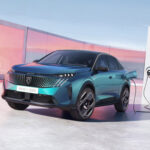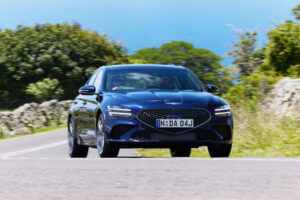
The Peugeot 508 has been on sale in Australia since July 2011. A mid-sized sedan or
station wagon, it fitted into the space between the smaller 407 and larger 607, effectively
replacing both cars.
The current (second generation) 508 arrived here in August 2021, only available in the
top-grade GT equipment level and featuring Peugeot’s first-ever plug-in hybrid (PHEV)
powertrain.
The previous petrol-only variants were dropped from the range at the end of 2022 leaving
just the more-expensive PHEVs.
STYLING
As has been the case throughout two body styles are offered: Fastback sedan and
Sportswagon.
Although our test car, the Sportswagon, is marginally longer than the Fastback both share
the same low and sleek profile with frameless door windows adding to the coupe-like
appearance.
The relatively small chequered radiator grille has chrome edge trim with the iconic Peugeot
Lion symbol in the centre and 508 lettering above it at the front of the bonnet. There are
twin headlights on either side above long curved turn indicators. ‘GT’ badges on the C
pillar complete the car’s ID.
The fuel filler is on the right rear panel and the battery charge point on the left.
INTERIOR
Interior space in the front is good, not to the extent of similarly sized SUVs but enough for
reasonable occupant comfort. Rear seat space is borderline with just enough legroom but
restricted headroom for taller passengers.
The 508 comes with the latest version of the Peugeot i-Cockpit which combines the small
sport steering wheel with a large head-up instrument panel and central infotainment touch
screen, blended together and ergonomically positioned.
The seats are quilted Nappa leather throughout with both front seats powered, heated and
with a multi-point massage function.
While there’s a physical volume button and a row of piano style keys immediately
underneath that provide quick access to various functions, the temperature controls are
digital and either side of the touchscreen.
Boot space in the Fastback is 487 litres with all seatbacks in place, expanding to 1537
litres with them folded. Sportwagon increases these capacities to 530 and 1780 litres
respectively.
A powered tailgate is standard in both variants.

POWERTRAINS
The 508 PHEV combines a 133 kW 1.6-litre turbo-petrol engine with an 11.8 kWh Lithium-
ion battery and 81 kW electric motor mounted on the front axle for a combined power
output of 165 kW.
Both variants are mated to an all-new Aisin eight-speed automatic transmission.
SAFETY
Standard in both 508 PHEV variants are six airbags; enhanced ABS brakes; dynamic
stability control; camera and radar activated emergency braking; blind spot detection;
adaptive cruise control with stop and go function.
There is also lane departure warning; lane keeping assistance with road edge detection;
driver attention alert; automatic high beam; IsoFix child seat mounts in the outer rear
seats; speed sign recognition and speed limit warning; forward collision warning; electronic
anti-skid system; and 180-degree rear-view camera.
INFOTAINMENT
Display is through a configurable 12.3-inch digital instrument panel in front of the driver
and a 10-inch high-definition touchscreen in the centre of the dashboard.
Embedded 3D satellite navigation is standard including voice recognition. There’s also
smartphone mirroring for Apple CarPlay and Android Auto, both wired as well as two USB
sockets in the front centre console and two more in the rear console plus 12V sockets,
including one in the boot.
Sound is through a FOCAL 10-speaker premium system with dedicated amplifier and
subwoofer. DAB digital radio is available for those who live in though areas where it can
be received.

DRIVING
Getting into the 508 for the first time, the cabin and driver’s seat feel a little cramped. The
low-slung styling can make it a bit awkward for taller occupants but it’s a sporty-ish car so
that’s to be expected. Once seated though the seats are comfortable and supportive.
Although the small squared-top sports steering wheel isn’t to everyone’s taste we loved it
not only for its feel but also because it provides an unobstructed view of the digital
instrument panel.
One of our least-favourite features in most new releases is lane correction which
automatically adjusts the vehicle’s steering, often quite vigorously, to keep it in the centre
of the lane. While we normally turn the feature off before we start our test, we found the
correction in the 508 quite subtle and were more than happy to let it do its job.
We love driving electric cars with their sharp, smooth and silent acceleration and the 508
PHEV provides plenty of that when it’s in EV mode.
Out on the open road the 508 is in its element with the ride and handling that has always
made Peugeots so popular with keen drivers. The GT tag is used far too often in current
cars and in most cases is meaningless. No so in the 508 GT because it is far closer to
being a Grand Tourer capable of cruising long distances through interesting drive routes.
Ride and handling are excellent, but it’s more of a touring car than a sports machine.
With an 11.8kWh battery capacity, the hybrid offers an electric only driving range of up to
55km (WLTP), which is could be enough for urban commuters. Having said that, the best
we could manage, in fairly moderate driving conditions, was 44 km.
Like all the other plug-in hybrids on the market that offer pure EV driving, Peugeot lists a
totally unrealistic fuel consumption figure of 1.8 litres per 100 kilometres for the 508. With
the battery fully-charged we covered 100 km using 3.4 L/100km.
Although that’s nearly double the listed figure it’s still very good. However, with the battery
expired, and running in normal hybrid mode including battery regeneration, we averaged a
less-impressive 6.4 L/100km.
SUMMING UP
Peugeot 508 is a superbly-crafted and stylish car that drew admiring looks wherever we
went.
But there’s much more because If you’ve had enough of the functionality and sensibleness
of an SUV and crave a bit of driving enjoyment then the Peugeot 508 could be just what
you’re looking for.
However, unless you can conveniently maintain a charge in the battery and limit the
distances travelled, then we feel the extra $17,000 that you now need to pay for the PHEV
over the, now discontinued, petrol-only equivalent GT just can’t be justified.
All Peugeot passenger vehicles come with a five-year, unlimited kilometre warranty
extended to eight years, but limited to 160,000 km, on the battery.
RATINGS:
Looks: 9/10
Performance: 9/10
Safety 8/10
Thirst: 8/10
Practicality: 7/10
Comfort: 7/10
Tech: 8/10
Value: 7/10
Overall: 8/10
AT A GLANCE
MODEL RANGE
508 1.6 GT PHEV Fastback: $81,610
508 1.6 GT PHEV Sportwagon: $82,915
Note: These prices do not include government or dealer delivery charges. Contact your
local Peugeot dealer for drive-away prices.
SPECIFICATIONS (Peugeot 508 Sportswagon 1.6-litre turbo-petrol PHEV five-door
wagon)
ENGINE:
Capacity: 1.598 litres
Configuration: Four cylinders in line
Maximum Power: 133 kW @ 6000 rpm
Maximum Torque: 300 Nm @ 3000 rpm
Fuel Type: Premium unleaded petrol
Combined Fuel Cycle (ADR 81/02): 1.8 L/100km (see comments in Driving)
CO2 Emissions: 40 g/km
DRIVELINE: Eight-speed automatic
DIMENSIONS, WEIGHT AND CAPACITIES:
Length: 4790 mm
Wheelbase: 2800 mm
Width: 1860 mm
Height: 1420 mm
Turning Circle: 10.8 metres
Kerb Mass: 1720 kg
Fuel Tank Capacity: 43 litres
BRAKES:
Front: Ventilated disc
Rear: Solid disc
STANDARD WARRANTY:
Five years / unlimited kilometres











